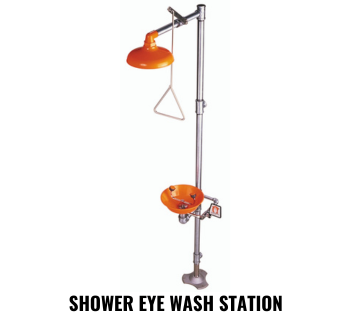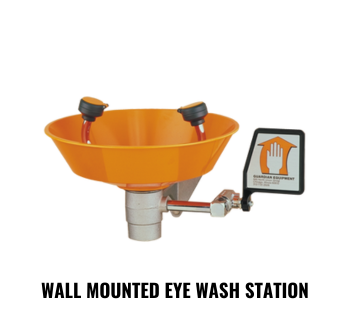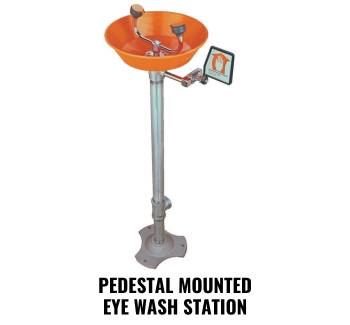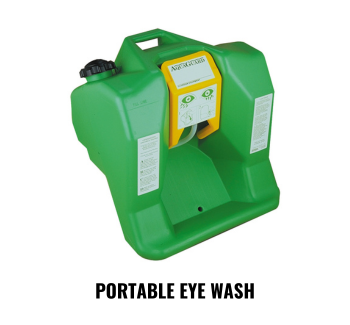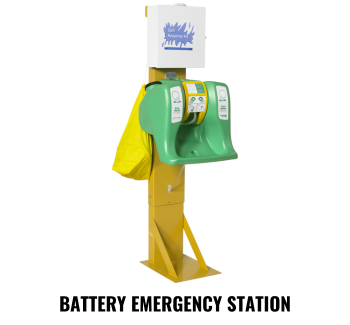We use cookies to make your experience better. To comply with the new e-Privacy directive, we need to ask for your consent to set the cookies. Learn more.
Emergency Eye Wash Stations: The Role of ANSI Z358.1 in OSHA Compliance
If employees might be exposed to “injurious corrosive materials,” employers have a legal responsibility to provide emergency eye wash and shower stations. The Occupational Health and Safety Administration (OSHA) is clear about that obligation — but OSHA stops short of describing the actual specifications of those eye wash/shower stations.
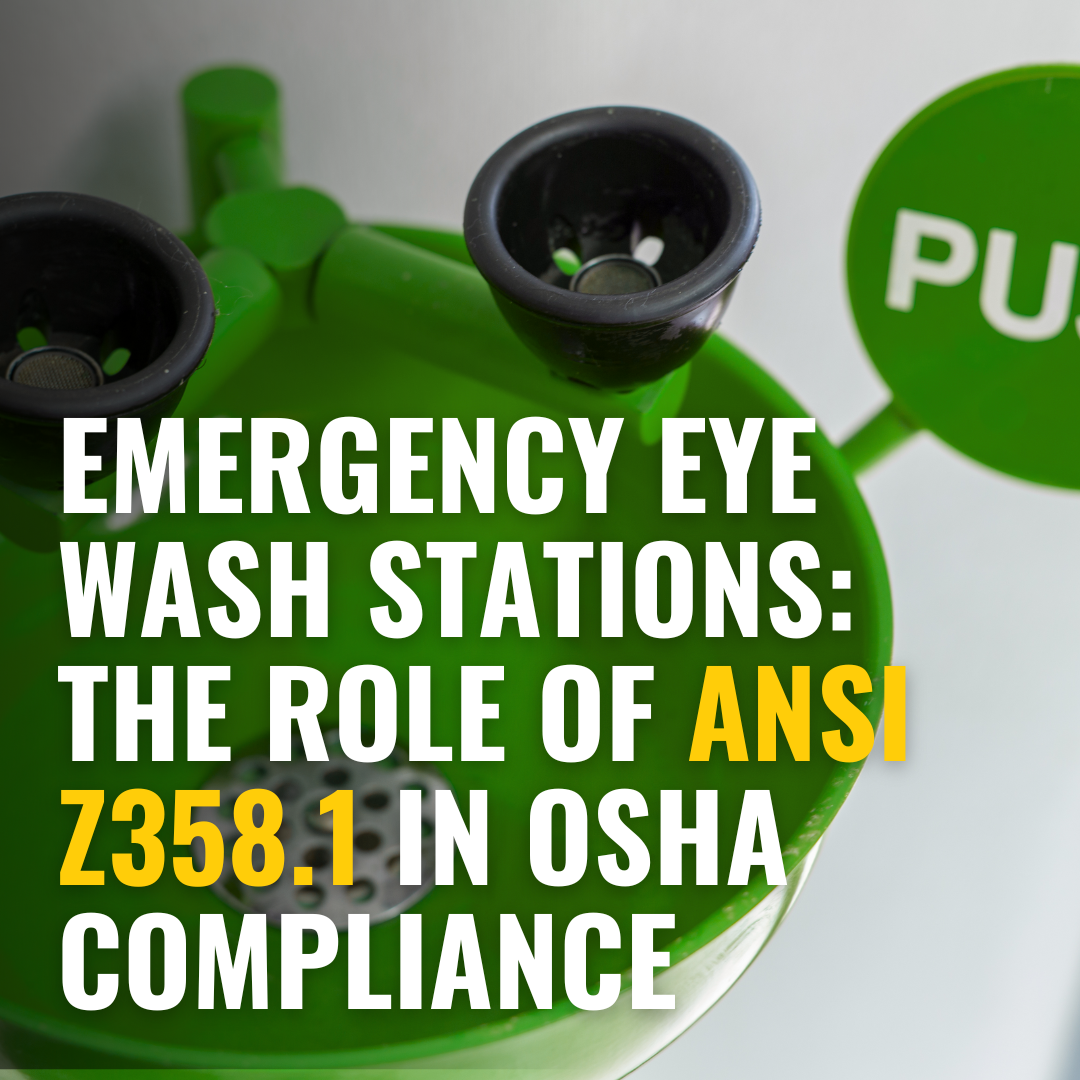
Why? For starters, there’s already a well-recognized standard: American National Standards Institute (ANSI) Z358.1. While ANSI Z358.1 does not have the force of an official regulation, it’s a reasonable ruleset with clear shower station specifications, installation, and maintenance.
ANSI is a private organization, and their standards are protected by copyright; we cannot reprint ANSI Z358.1 in its entirety. However, in this article, we’ll address some common questions about eye wash stations, ANSI, and OSHA requirements — and provide tips for improving compliance at your operation.
Why do eye wash stations need to follow ANSI Z358.1?
Technically, OSHA doesn’t mandate ANSI Z358.1 or any other private standard. As discussed above, ANSI standards are not regulations.
But OSHA’s standards for emergency eye wash and shower stations are fairly straightforward. Per OSHA 1910.151(c):
“Where the eyes or body of any person may be exposed to injurious corrosive materials, suitable facilities for quick drenching or flushing of the eyes and body shall be provided within the work area for immediate emergency use.” [Emphasis added.]
OSHA 1926.50(g), which applies to the construction industry, has identical wording.
The key word here is “suitable.” OSHA’s standards do not describe what suitable means, but interpretation letters have identified ANSI Z358.1 as a reasonable standard.
In a May 5, 2004 interpretation letter, OSHA director Richard E. Fairfax wrote:
…the current ANSI standard addressing emergency eye wash and shower equipment (ANSI [Z]358.1-2004) provides for eye wash and shower equipment in appropriate situations when employees are exposed to hazardous materials.”
You’re free to follow another resource when establishing emergency stations at your facility — but finding those resources may be difficult. In the same interpretation letter, Fairfax recommends consulting “additional recognized references such as W. Morton Grant’s Toxicology of the Eye.”
The bottom line: ANSI Z358.1 is a reasonable standard for fulfilling the “suitable facilities" requirement of OSHA’s 1910.151(c).
Does ANSI Z357.1 apply specifically to eye wash stations?
Yes, but the standard also includes specifications for other types of emergency equipment:
- Emergency showers
- Eye wash stations
- Eye-and-face wash stations
- Combination shower/eye/face wash stations
- Personal wash units and drench hoses (considered supplemental equipment — not a replacement for dedicated shower and eye wash stations).
For OSHA compliance, employers generally must provide both emergency showers and eye wash stations. Personal wash units are also a savvy investment if workers might encounter a chemical hazard in different areas of your facility.
What does ANSI Z358.1 require for eye wash station manufacturers?
ANSI standards are fairly complex, but some of the primary requirements for eye wash stations include:
- The equipment must control flushing fluid’s (water or specialized solutions) velocity and quantity.
- Wash stations must release flow within one second or less, and controls should be easy to use.
- Eye wash stations must have a minimum flow rate of 0.4 gallons per minute.
- Combination eye-and-face wash equipment must have a minimum flow rate of at least 3 gallons per minute.
- Wash station valves must be corrosion-resistant.
- Wash fluid should be “tepid,” with a temperature between 60 and 100 degrees Fahrenheit (16 to 38 degrees Celsius).
Note that emergency showers have different requirements. In a 2002 standard interpretation letter, OSHA noted several key ANSI specifications for emergency showers:
- The shower must be able to deliver at least 75.7 liters per minute (20 gallons per minute) of water or flushing fluid.
- The velocity of the fluid must be low enough to avoid injury.
- The wash system must be able to maintain this flow rate for at least 15 minutes.
What types of “injurious chemicals" require emergency eye wash and shower stations?
Corrosive materials with a very low or high pH qualify as potentially injurious. In interpretation letters, OSHA gives examples that include sodium hydroxide (lye) and sulfuric acid (battery acid).
You must provide showers and eye wash stations if employees are exposed to those chemicals. Per 29 CFR 1910.1200(c):
"Exposure" or "exposed" means that an employee is subjected in the course of employment to a chemical that is a physical or health hazard, and includes potential (e.g.,, accidental or possible) exposure. "Subjected" in terms of health hazards includes any route of entry (e.g., inhalation, ingestion, skin contact or absorption.)
Note that this is a fairly broad definition. If you have battery-powered forklifts, for example, your employees may be exposed to sulfuric acid at some point — even if that’s unlikely during typical work activities.
If you’re not sure whether your facility needs eye wash stations, consult the Material Safety Data Sheets (MSDS) for products used in the facility. Materials are “injurious" if any of the following statements are true:
- The product is corrosive (a very high or low pH).
- The product contains 0.1% or more of formaldehyde or methylene chloride.
- The material contains carcinogens (ethyleneimine or beta-propiolactone).
- The material can cause irreversible eye damage.
Related: How an Eyewash Station Could Save Your Vision
For OSHA compliance, where should I place eye wash stations and emergency showers?
OSHA standard 1926.441(a)(6) applies specifically to battery rooms and states:
Facilities for quick drenching of the eyes and body shall be provided within 25 feet (7.62 meters) of battery handling areas. [Emphasis added]
For other chemical hazards, you simply need to make eye wash stations accessible for “immediate emergency use.” Once again, that’s a good rule of thumb for OSHA compliance: ANSI requires that eye wash stations can be reached within 10 seconds of exposure.
In an emergency, “10 seconds" is about 55 feet, though the layout of your facility might impact that estimate. You can also contact your state OSH office for clarification.
What maintenance is required for eye wash stations?
Weekly activations are crucial — in an emergency, you certainly don’t want stagnant water.
- Remember the “5 minutes per week" rule. For plumbed units, turn on (activate) the shower or eye wash station and run it for about five minutes at least once per week.
- At least once per year, double-check the water temperature and flow rate.
- Keep track of your annual and weekly inspections. Remember, an accurate and consistent paper trail will help you during OSHA inspections or when on-the-job injuries occur.
- Make sure emergency showers and eye washes are identified with highly visible signage.
- Train employees, especially workers who water batteries or work directly with other types of corrosive chemicals. Make sure your staff can identify the stations and understand how to use them in an emergency.
What should I know when choosing emergency eye wash stations?
Look for products that are designed to meet or exceed ANSI Z358.1. Solus Group carries several ready-to-use products designed to make compliance easy:
The Shower Eye Wash Station features an open ball valve, actuating arm, and pull rod for simple operation. Its self-regulating flow provides a gentle spray, while an IPS chrome-plated brass shower valve resists corrosion.
The Wall Mounted Eye Wash Station comes standard with open ball valves, filters, and float-off dust covers. It mounts easily to any wall, providing a permanent solution for battery rooms and other areas with chemical hazards.
The Pedestal Mounted Eye Wash Station also features a self-regulating flow control valve, stay-open ball valves, filters, and float-off dust covers with a pedestal mount design.
The Portable Eye Wash is a self-contained, 16-gallon system that aids in compliance throughout your facility. It provides 15 minutes of flushing solution at a complaint flow rate of 0.4 gallons/minute through dual spray heads.
The Battery Emergency Station includes a Portable Eye Wash, Battery Emergency Stand, and additional critical safety supplies. After anchoring to the floor, it offers a complete, convenient solution for battery rooms and other environments.
Solus Group can help you find eye wash stations, emergency showers, personal protective equipment (PPE), and everything else your business needs to operate safely and efficiently. For more information and guidance, call our sales team at (314) 696-0200.

